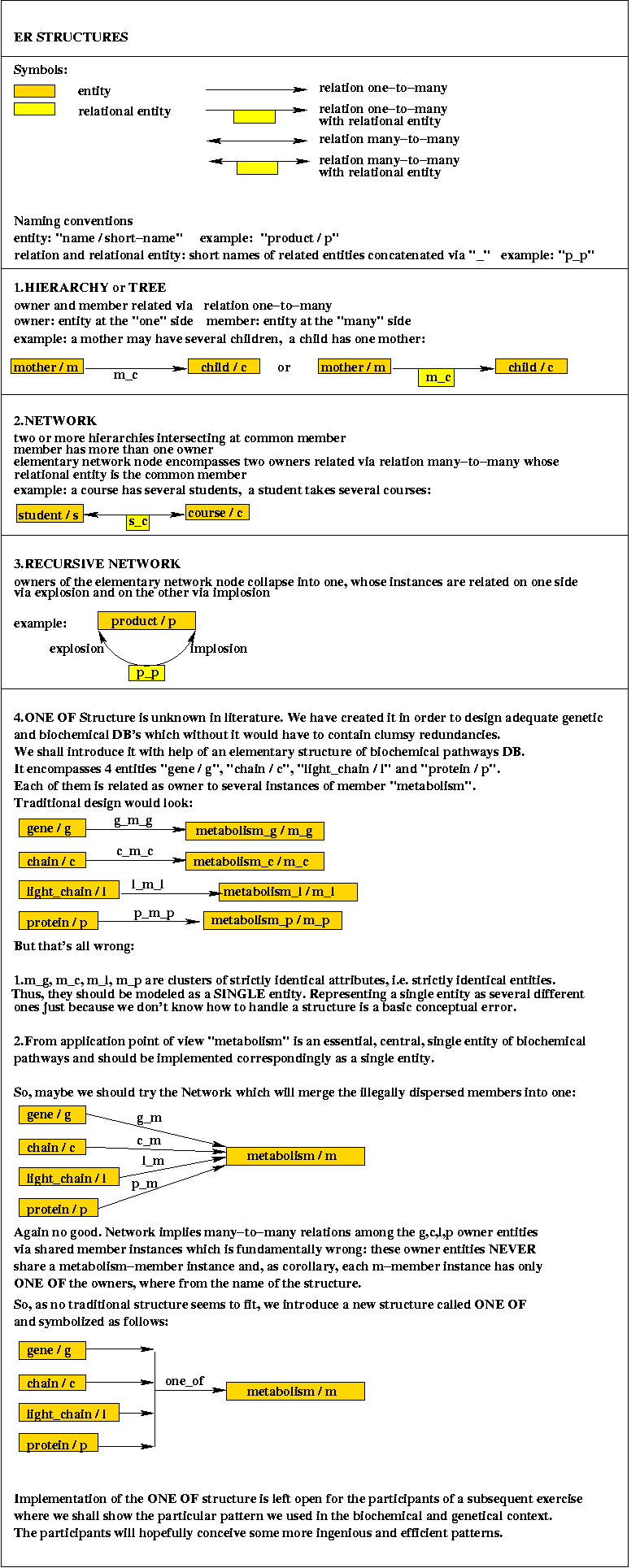======================================================================
This first course of Computer Modeling defines some essential modeling
concepts based as closely as possible upon the current state of the
Set Theory. Further, it shows four elementary structures, which support
to the best of our knowledge all modeling patterns.
======================================================================
Human reason starts with physical sensations. In the next step they are
abstracted, classified and memorized as sensation types or ATTRIBUTES.
Further abstraction collects clusters of ATTRIBUTES into ENTITIES.
These lines may appear surprising, as one may ask "attribute of what?"
thus postulating primary existence of an "empty" entity, subsequently
"filled" with attributes. We touch here one of the oldest philosophical
interrogations about existence of such "empty entities" or "noumena".
Modern, contemporary Weltanschaung started with Kant who banned noumeon
("Ding an sich", or "Thing as such") from the human Universe of Discourse
and restricted it to Phenomena, or Entities encompassing exclusively
Attributes and nothing else.
Following in his steps we shall consider ATTRIBUTE as elementary ENTITY
and more complex ENTITIES as collections of ATTRIBUTES.
Further abstraction process adds to purely sensual Attributes new,
imaginary, emotional, logical, aesthetical and ethical ones, such as
"beautiful", "wrong", etc.
Rationality starts when Reason detects and addresses ORDER emerging
from the original CHAOS of contingent distribution of Entities.
Entities become Ordered or RELATED via several different criteria.
We may say without exaggeration that any rational investigation deals
one way or another with STRUCTURES or INTERRELATED Entities.
Most generally RELATION will denote criteria ordering particular
ENTITIES.
Chaos and Order is the most advanced contemporary scientific issue
addressed by Thom's Morphogenetics and Theory of Catastrophes and by
Haken's Synergetics. It exceeds by orders of magnitude the scope of
the present course. In the near future a resume will be available
in:
http://evans-experientialism.freewebspace.com/metanomskiindex.htm
As far as Computer Modeling is concerned we may resume the issue as
follows:
A.ENTITY / RELATION (ER) Model is the only rational base of a Computing
System endeavoring to truly represent the reality.
B.Set Theory is the state-of-the-art foundation of ER Models.
Consequently, we shall design ER Models exclusively with help of Set
Theory concepts. For user friendliness' sake we shall use wherever
possible synonyms of these concepts more familiar to Computing
specialists. However, we shall use only precisely defined synonyms,
in order to avoid misunderstandings.
Indeed, the domain of Computing Modeling and Design is muddled beyond
imagination by pseudo scientific handbooks ignoring all about real
science and presenting some "kitchen" level second hand "experience".
If we want to design a pertinent system we have to start by forgetting
and throwing to trash all pseudo scientific handbooks, by endeavoring
to think by ourselves and by trying to design a rigorous ER Model based
directly upon the Set Theory.
It may look tough and complex at the first glance, but in reality it
boils down to an incredible simplification: all that proper Set Theory
based ER Model uses are 4 (FOUR !!) types of Structure. They are shown
in the Appendix and you can bet your shirt that you can learn and
understand them in one or two hours.
This simplicity moves the real difficulty where it belongs: to the
creative imagination necessary to build complex edifices with these
simple bricks. A bit like using simple, common faculty of voice to
sing Bach cantatas or Negro Spirituals.
======================================================================
SOME DEFINITIONS AND DESCRIPTIONS
======================================================================
SET and CLASS
A SET is a CONCRETE ENTITY. It may CONTAIN SETS as ELEMENTS. It may
be contained in an AGGREGATE SET or in an AGGREGATE CLASS as an ELEMENT.
It may be INCLUDED in a SUPERSET SET or in a SUPERCLASS CLASS as a
SUBSET.
A CLASS is a VIRTUAL ENTITY. It is a rule allowing to verify if some
existing ENTITY or SET is its ELEMENT. It may be INCLUDED as a SUBCLASS
in a SUPERSET or in a SUPERCLASS . It may not be CONTAINED as an ELEMENT
in a SET nor in a CLASS.
======================================================================
Usual SYNONYMS used in computing
======================================================================
OWNER or PARENT.
1.Concrete: AGGREGATE SET or AGGREGATE CLASS depending on context.
Model deals exclusively with CLASSES. Programming deals with SETS, while
using CLASSES as guiding patterns.
2.Virtual: SUPERSET or SUPERCLASS depending on context as above.
MEMBER or CHILD.
1.Concrete: ELEMENT or SUBSET.
2.Virtual: SUBCLASS.
INSTANCE or OCCURRENCE (of a CLASS).
SUBCLASS or ELEMENT.
======================================================================
RELATIONAL ENTITY
Some relations define Attributes pertaining to tuples of related Entities.
A cluster of such Attributes as any cluster of Attributes is an Entity.
Such Entity pertaining to a particular Relation will be called RELATIONAL
ENTITY.
======================================================================
ER MODEL deals with (Virtual) Entities and (Class) Relations.
======================================================================
Implementation of ER MODEL is ER SCHEMA depending upon a DB. In the case
of SQL DB Schema Entities are Table Definitions and Schema Relations
are Structures of Tables.
======================================================================
APPENDIX
Four elementary ER Structures.
 |
======================================================================

